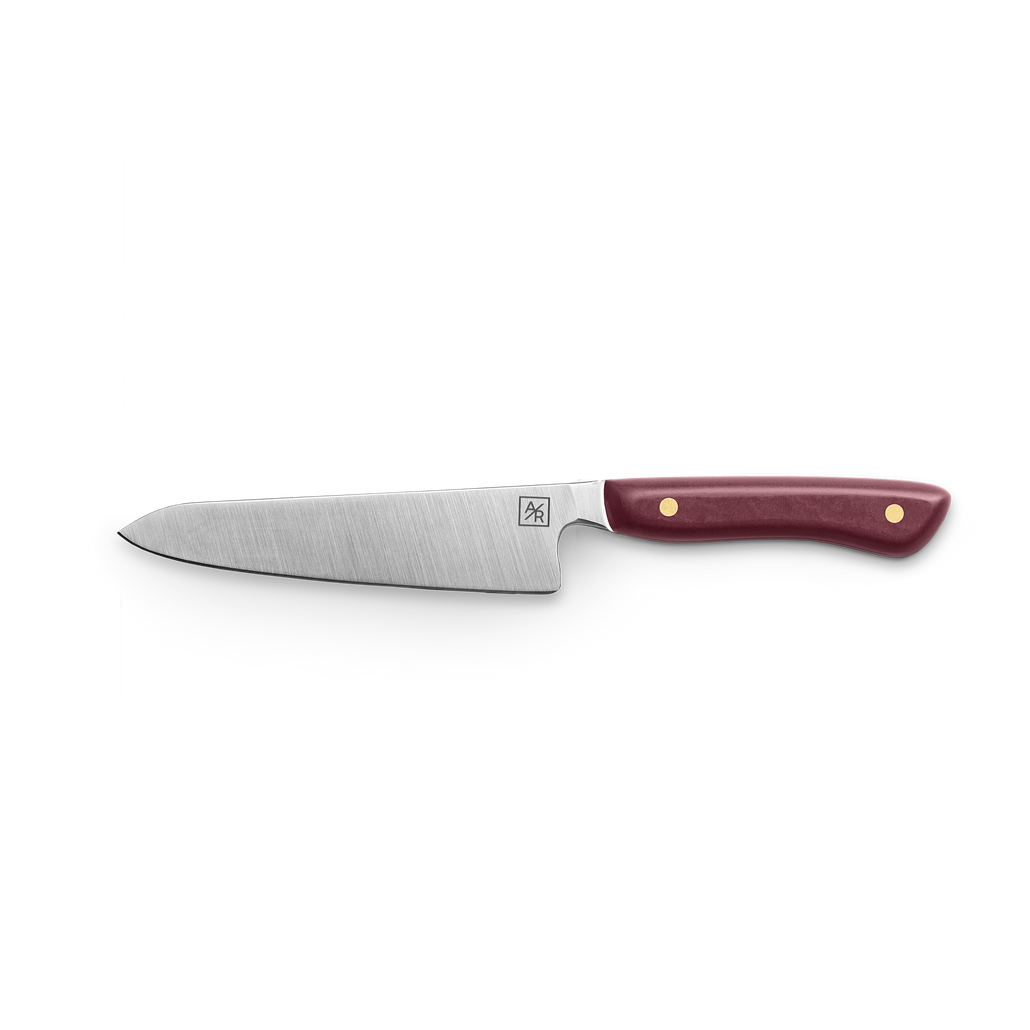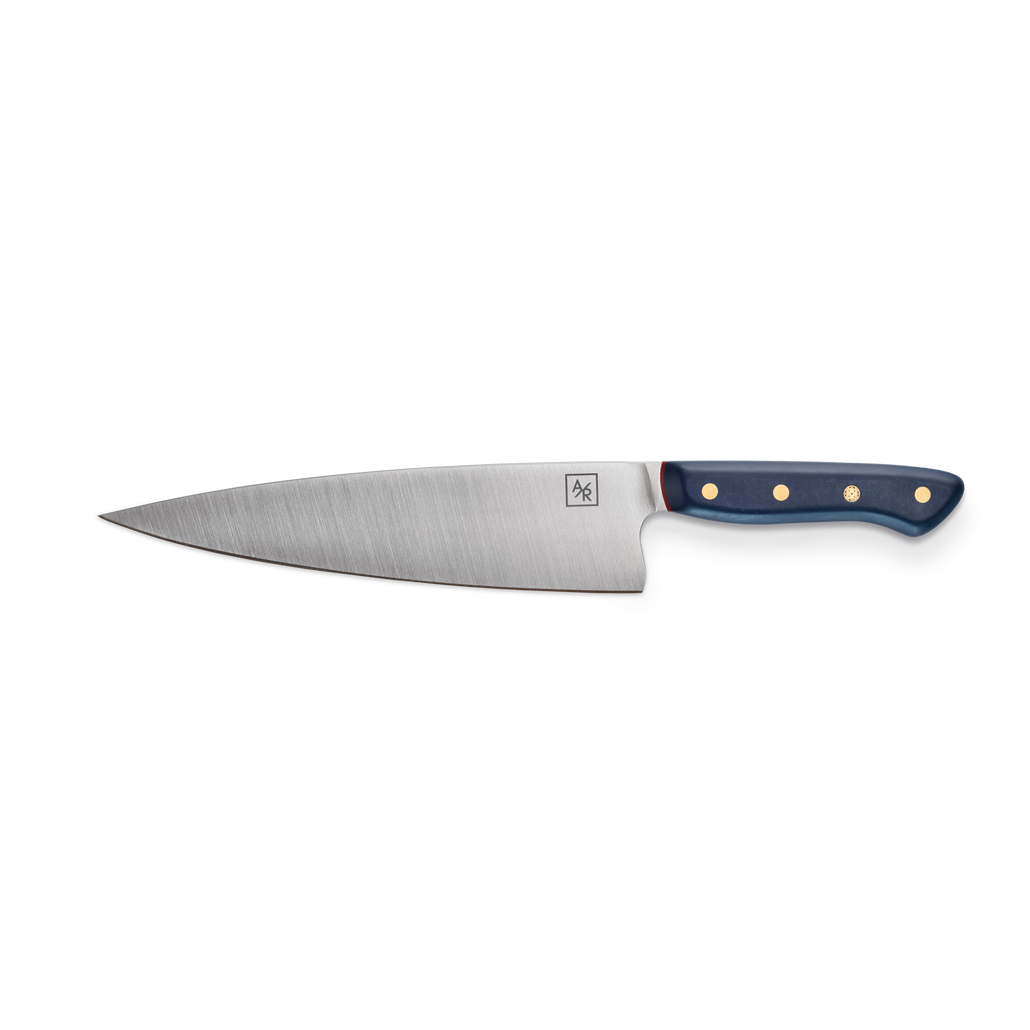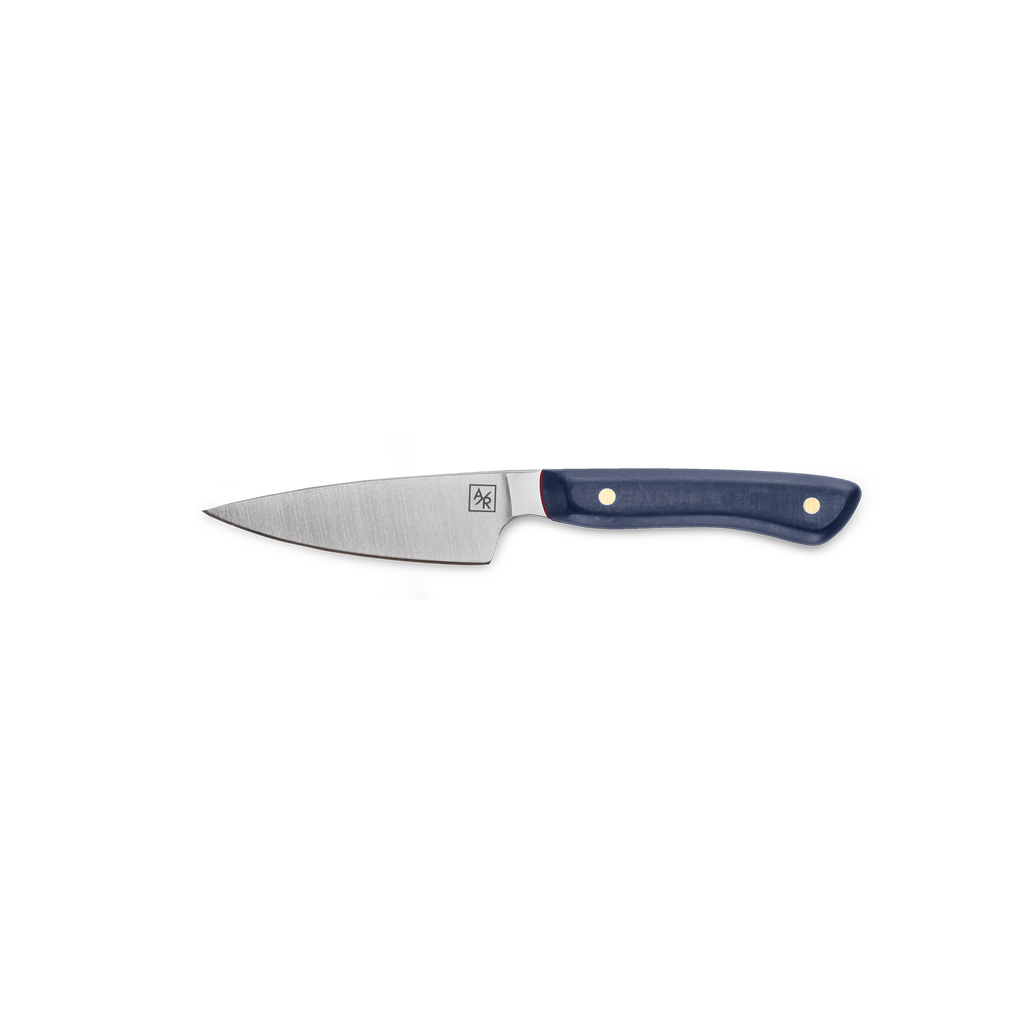CARE FOR YOUR KITCHEN KNIFE SO IT LASTS FOREVER
8 Rules For Maintaining Like-New Knives
5 MINUTE READ
BY: DAVID OLKOVETSKY
Taking care of your kitchen knife isn’t as hard as it seems. And while it might be tempting to let your knife sit with the other dishes in the sink (don’t do it), or toss it haphazardly into the dishwasher (really, don’t do it), regular maintenance will make a world of difference. Even if you fall into the camp of "I cook only to survive", you'll find that when your knife maintains its incredibly sharp edge, and glides effortlessly through rib eyes and rock-hard squash alike, you'll start to truly enjoy rolling up your sleeves and conquering the kitchen.
Here’s what you need to know, to keep your knives in mint condition:
Contents
Use Your Knife On Food & Only Food
Perhaps it’s obvious—but it needs to be said.
Think about it: the number of times you’ve used your kitchen knife to pry open a can, open boxes, break down a small animal, and hammer through frozen foods. Any of these can and will dull, twist, or chip your blade because your kitchen knife is designed to cut through (non-frozen) foods only. Using it for any other purpose can seriously damage your cutting edge. Specialty boning knives are meant exclusively for breaking down poultry, bone-in meats, and fish—so don’t use your chef knife, santoku, or nakiri for hacking through bones.
Wash & Dry - Every Single Time
hen you’re done with meal prep, wash your knife with dish soap and warm water. When washing your knife, please make sure to use a non-scratch sponge. Some sponges use aluminum oxide on the abrasive side, which can leave scratch marks on your blade and dull your edge. After washing, dry your knife immediately. We recommend knife magnets for storage (more on that later).
The experts at Artisan Revere have seen the most expensive knives fall victim to rust spots, discoloration, and worse—just from being left out on the counter, or with all the other dirty dishes in the sink. It’s best to avoid an expensive lesson, and take just a few seconds to take care of your kitchen knife. There are quite a few products out there for removing rust, like Bark Keeper's Friend and Simichrome. However, the best product we've found for cleaning up discoloration is Shadazzle, and we can't recommend it highly enough.
Treat Your Knife With Food-Grade Mineral Oil
An occasional drop or two of food grade mineral oil throughout the handle and the blade can keep your blade from reacting to highly acidic foods like lemons and limes. It will also prevent acidic or salty solutions from stripping your blade of its free chromium layer, which is a fancy way of saying it will prevent patina, or worse, rust. Food grade mineral oil isn’t just great for preventative knife care; it can also reverse early patination on a non-stainless blade. Any food-grade mineral will do the trick—and they also work wonders for your cutting board. If your knife is a high-carbon, “non-stainless” blade, you should apply a layer of food grade mineral oil after every single use, as this will prevent corrosion.
If you’ve already got some corrosion, as evidenced by orange spots on your blade, we suggest attempting to remove it with Shadazzle.
Shop Our Knives
4. Use The Right Cutting Board
There are only a few cutting boards that you should use to keep your knife sharp and maintain a sanitary kitchen: wood, plastic or synthetic rubber. Stick with wooden cutting boards, made with walnut, cherry ,or maple wood for fruits and vegetables. The janka hardness of walnut and cherry woods is just right for your knives, while maple is a bit harder and less expensive, but will require more frequent sharpening. We offer a best-in-class, rescued end-grain custom quality board, but there are also less pricey face-grain options (note: they'll dull your knives much faster).
Plastic boards are inexpensive, and absolutely fine for fruits and vegetables, but these boards are best used for meats and fish because they can be sanitized in the dishwasher. Remember to replace your plastic boards once they start to get too many deep scars—that's where bacteria like to reside.
Additionally synthetic rubber boards, like this one from Hasegawa, are superb for advanced knife users who primarily employ slicing motions—they’re grippy and also do less damage to your knives. Rock choppers should avoid these as the boards are a bit too soft.
Make sure you avoid man made materials such as Paperstone, Richlite, glass, granite, ceramic—these will rapidly ruin your knives. Additionally stay away from teak, and bamboo—two natural materials that are very high in silica, which will drastically decrease how long your knife stays sharp. Don’t fall into the trap of buying anything but wood, plastic or rubber boards.
To learn more about cutting boards, visit our Definitive Guide to Cutting Boards.
5. Use A Bench Scraper For Food Transfer, Not Your Knife's Edge
If you’ve been using your knife’s edge to transfer foods and organize your cutting board, you’re not alone—many top chefs we’ve worked with do this too. Here’s the bad news, this is the easiest way to roll your knife’s edge, especially on those thinner knives.
Avoid this practice before it becomes tough to break the habit. We suggest picking up an inexpensive bench scraper for under $10. Space constrained? No problem, use the spine of your blade to transfer food.
6. Stay Away From the Dishwasher
We’ll put it this way: your dishwasher is a hurricane of scorching hot water and highly abrasive detergent. It’s a perfect storm that can chip, dull, and corrode your knives. Not to mention the high likelihood of pitting corrosion—a particularly nasty, localized form of corrosion. Even if your blade miraculously comes out of the dishwasher intact, the high temperatures and wet conditions will rapidly eat away at the epoxy that holds your handle together—translation: you’ll ruin your gorgeous knife, guaranteed.
Keep your knife away from the dishwasher at all costs, and clean it by hand only. PSA: the dishwasher voids most knife warranties.
7. Use Magnets For Storage & Sheaths For Transport
The best place to store your knives is on a magnet. Wood or bamboo covered magnets are best, as they’re not as harsh on your knives as steel magnets: steel on steel is never ideal. Large wooden blocks are sub-optimal for several reasons: they’re difficult to clean, dull your knife edge, and take up unnecessary space.
Importantly, when placing your knife on or removing your knife off a magnet, remember to maintain spine contact. Place the knife on the magnet via the spine of the blade, and then slowly rotate the knife face onto the magnet. Reverse this when removing the knife. Avoid any contact between the cutting edge and the magnet—this will keep your edge sharper for longer and you won’t cut into the magnet.
Leather sheaths, as well as wooden and plastic sayas are great for transportation, but you should avoid them for long-term storage, unless your knife is 100% clean and dry. Any of these enclosures will retain moisture, and moisture is the enemy of steel, even if your knives are “stainless”. The result: minor patination, or serious corrosion for carbon blades. If you do use a sheath or saya, make sure to first apply a drop of food grade mineral oil to create a protective barrier between the steel and the sheath.
Each Artisan Revere knife comes with a custom-quality leather sheath included for storage and transport.
What Makes Leather So Special For Sheaths & Sayas?
Safety. The friction of a leather saya, when constructed correctly, holds the knife in place snugly. Wood and plastic often don't.
Gentle. Leather is far gentler on knife edges. This is the top hidden issue with kydex and wood.
No pin to lose. This is the top complaint re: wooden sayas.
Tight fit for a broad array of knives. Our sayas are designed to fit a broader array of knives within a category. This is simply not possible with wood and kydex.
Sturdy and stable in all humidities. Leather doesn't warp or crack. Wood will warp or crack if moving between high and low moisture environments.
8. Know When It's Time To Hone & Sharpen A Kitchen Knife
All knives will eventually dull as the steel abrades over time. Artisan Revere uses a 3rd generation high alloy particle metallurgy tool steel (which is 30x more expensive than generic knife steel) that will stay sharp much longer—but even our knives will eventually need a tune-up.
We suggest weekly ceramic rod honing for home cooks and daily for professional cooks. Cook’s Standard makes a quality, fairly priced ceramic rod. Remember to wipe your blade down after you’ve honed it. A good alternative is to hone your knife on the WorkSharp Elite Sharpening Solution's 3000 grit belt.
If your knife can no longer easily pierce a tomato with a slicing motion and minimal pressure, we recommend you run it for 5-10 passes per side on the WorkSharp, or retouch it on your whetstones. Once you’ve sharpened your knife, test it out on a tomato or pepper, or try to slice (not push) through a piece of paper on a diagonal. Your cuts should be smooth and effortless. Any kinks, and you’ve got to do some more sharpening in that area.
MAKE YOUR KNIFE LAST FOREVER.
And there you have it. Eight easy steps to take care of your kitchen knife—brought to you by Artisan Revere.
Pro-tip: Invest in a quality kitchen knife that’s designed to last longer from the get-go. Check out the Artisan Revere Chef’s Knife, made with Elmax High Vanadium Super Steel, for an edge that stays sharp 2.31 times longer than other premium knives.
Shop Our Top Tools
Customer Reviews
As I've gotten older, I've begun to recognize the importance of eating handmade food from fresh ingredients. Not only is the food healthier, it tastes tremendously better.
However, a good knife is one of the areas I've neglected in my pursuit of crafting handmade food. For some reason, I've held the perception that a knife is a knife is a knife. I was wrong.
Before Christmas, I decided that I wanted to treat myself and invest in my last knife. To support my efforts in finding the right knife, I use the following prompt in ChatGPT:
== BEGIN PROMPT ==
You are a master chef who specializes in US independent knife makers.
I'm in the market for a new chef's knife. I am looking to spend less than $400. I want a knife that is known for flexibility, retaining its edge, and durability. Give me some of the best options from US independent knife makers.
Create a table with the top ten options with links to their sites.
== END PROMPT ==
Artisan Revere was one of the companies listed. After following up with other prompts to refine what I was looking for, everyday use retains its edge and ease of maintenance, it was clear that Artisan Revere was the best option for me.
Although I spent more than I initially planned, having used my Artisan Revere chef's knife for the past three months, I couldn't be happier with my investment and feel it was worth every penny.
Having such a good knife pushed me to invest in a better cutting board and has encouraged me to push my already fanatical passion for cooking even further, which has had a corresponding impact on my enjoyment of the entire cooking experience.
And while I could go on and on about the tremendous attributes of my knife, what I appreciated even more was David Olkovetsky, the CEO, calling me to understand my cooking style and confirm I had what I needed to take care of my knife. This level of hospitality, combined with a tremendous product, has made me a fan that will only ever use and gift Artisan Revere knives.
If you're on the fence about investing in a knife. You'll never regret investing in an Artisan Revere knife.
We bought 2 chef's knives for a couple of our customers as an end of project gift. It was awesome to find such high quality knives, they look and feel amazing. David the owner of Artisan Revere was very helpful and even helped us get the customers names engraved on the leather sheath and knife.
The Artisan Revere chefs knife cuts with ease, is super well balanced, and keeps a sharp edge for longer than any of my Wustofs or other European knives. The edge is perfect and the knife is dulled in the exact areas where your fingers might be exposed. The leather sheath is a more plus for protecting the knife. The materials are top notch and are lightweight allowing for fast and easy cutting. You simply are less tired after using this knife compared with others.
Being somewhat of a knife geek, I have a multitude of knives, including ten chef's knives and Santukos of German, Japanese, and American steels in both German and Japanese knives. I researched this and other premium American made blades before purchasing this knife, mainly based on steel technology, but also its light weight. I also appreciated a 1:1 conversation with David to discuss the technology and craftsmanship before I ordered. After using this knife for six months, it is now my favorite knife for most all tasks that don't involve cutting foods that are prone to sticking to the blade, e.g., potatoes, (Glestain specialty Santuko for that unique task), or butternut squash, bones, etc. (Henckles and a rubber mallet for that).
It excels at precision cuts, like brunoise cut veggies, and prepping meat and fish. It is as light as the best custom Japanese knives I have, but sharper and better balanced. It is very well made. It maintains an edge significantly better than any other knife I own. In fact, I haven't sharpened it once in six months and it's still a razor. Its blade and handle geometry is superb. It fits my hand perfectly.
My guests may be impressed by some of the beautiful Japanese knives I have displayed in the block, but this is the one I use all the time and appreciate the most. I keep it in its handsome sheath in my drawer away from curious guests who might otherwise cut themselves, or god forbid, drop it. Well worth the money!
This is the ultimate knife. You will never need to buy another knife in your lifetime. A one-time forever purchase. Nothing even remotely comparable out there.
View Our Top Articles

























